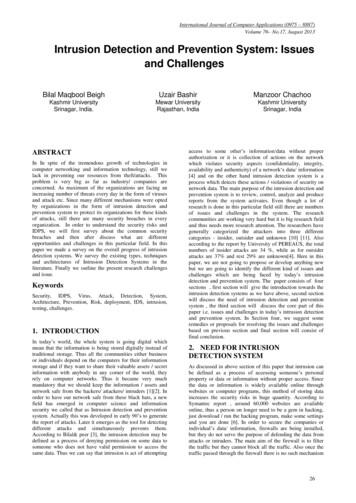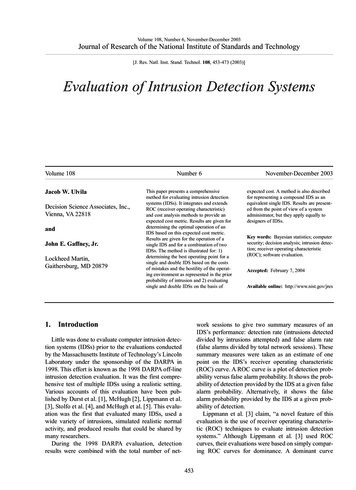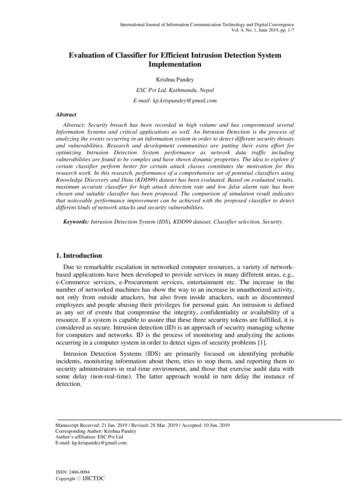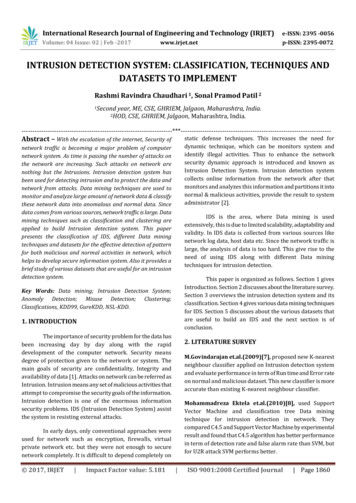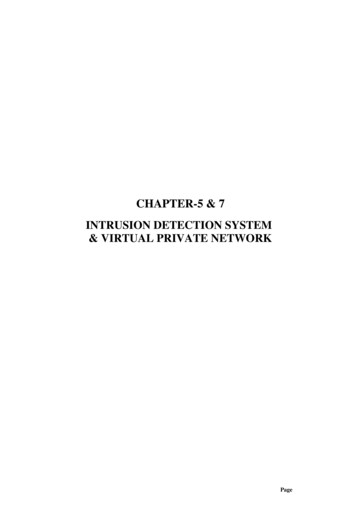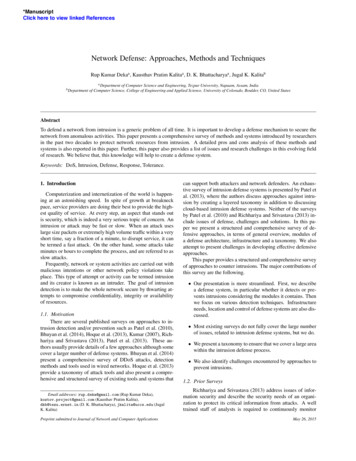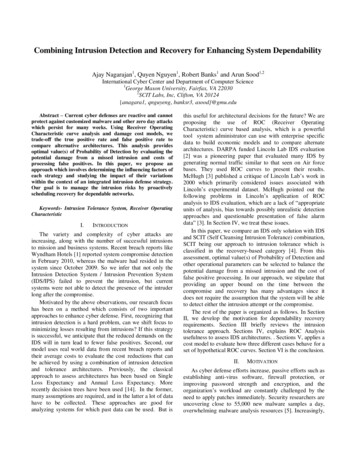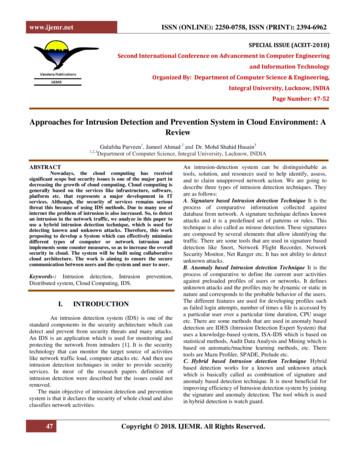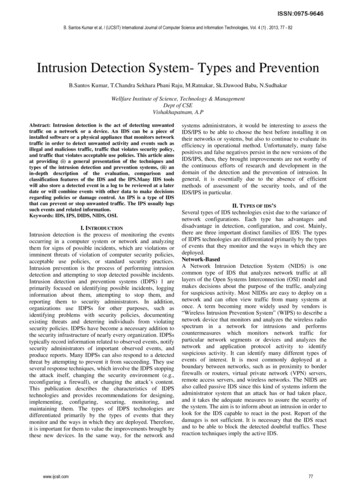
Transcription
B. Santos Kumar et al, / (IJCSIT) International Journal of Computer Science and Information Technologies, Vol. 4 (1) , 2013, 77 - 82Intrusion Detection System- Types and PreventionB.Santos Kumar, T.Chandra Sekhara Phani Raju, M.Ratnakar, Sk.Dawood Baba, N.SudhakarWellfare Institute of Science, Technology & ManagementDept of CSEVishakhapatnam, A.PAbstract: Intrusion detection is the act of detecting unwantedtraffic on a network or a device. An IDS can be a piece ofinstalled software or a physical appliance that monitors networktraffic in order to detect unwanted activity and events such asillegal and malicious traffic, traffic that violates security policy,and traffic that violates acceptable use policies. This article aimsat providing (i) a general presentation of the techniques andtypes of the intrusion detection and prevention systems, (ii) anin-depth description of the evaluation, comparison andclassification features of the IDS and the IPS.Many IDS toolswill also store a detected event in a log to be reviewed at a laterdate or will combine events with other data to make decisionsregarding policies or damage control. An IPS is a type of IDSthat can prevent or stop unwanted traffic. The IPS usually logssuch events and related information.Keywords: IDS, IPS, DIDS, NIDS, OSI.I. INTRODUCTIONIntrusion detection is the process of monitoring the eventsoccurring in a computer system or network and analyzingthem for signs of possible incidents, which are violations orimminent threats of violation of computer security policies,acceptable use policies, or standard security practices.Intrusion prevention is the process of performing intrusiondetection and attempting to stop detected possible incidents.Intrusion detection and prevention systems (IDPS) 1 areprimarily focused on identifying possible incidents, logginginformation about them, attempting to stop them, andreporting them to security administrators. In addition,organizations use IDPSs for other purposes, such asidentifying problems with security policies, documentingexisting threats and deterring individuals from violatingsecurity policies. IDPSs have become a necessary addition tothe security infrastructure of nearly every organization. IDPSstypically record information related to observed events, notifysecurity administrators of important observed events, andproduce reports. Many IDPSs can also respond to a detectedthreat by attempting to prevent it from succeeding. They useseveral response techniques, which involve the IDPS stoppingthe attack itself, changing the security environment (e.g.,reconfiguring a firewall), or changing the attack’s content.This publication describes the characteristics of IDPStechnologies and provides recommendations for designing,implementing, configuring, securing, monitoring, andmaintaining them. The types of IDPS technologies aredifferentiated primarily by the types of events that theymonitor and the ways in which they are deployed. Therefore,it is important for them to value the improvements brought bythese new devices. In the same way, for the network andwww.ijcsit.comsystems administrators, it would be interesting to assess theIDS/IPS to be able to choose the best before installing it ontheir networks or systems, but also to continue to evaluate itsefficiency in operational method. Unfortunately, many falsepositives and false negatives persist in the new versions of theIDS/IPS, then, they brought improvements are not worthy ofthe continuous efforts of research and development in thedomain of the detection and the prevention of intrusion. Ingeneral, it is essentially due to the absence of efficientmethods of assessment of the security tools, and of theIDS/IPS in particular.II. TYPES OF IDS’SSeveral types of IDS technologies exist due to the variance ofnetwork configurations. Each type has advantages anddisadvantage in detection, configuration, and cost. Mainly,there are three important distinct families of IDS: The typesof IDPS technologies are differentiated primarily by the typesof events that they monitor and the ways in which they aredeployed.Network-BasedA Network Intrusion Detection System (NIDS) is onecommon type of IDS that analyzes network traffic at alllayers of the Open Systems Interconnection (OSI) model andmakes decisions about the purpose of the traffic, analyzingfor suspicious activity. Most NIDSs are easy to deploy on anetwork and can often view traffic from many systems atonce. A term becoming more widely used by vendors is“Wireless Intrusion Prevention System” (WIPS) to describe anetwork device that monitors and analyzes the wireless radiospectrum in a network for intrusions and performscountermeasures which monitors network traffic forparticular network segments or devices and analyzes thenetwork and application protocol activity to identifysuspicious activity. It can identify many different types ofevents of interest. It is most commonly deployed at aboundary between networks, such as in proximity to borderfirewalls or routers, virtual private network (VPN) servers,remote access servers, and wireless networks. The NIDS arealso called passive IDS since this kind of systems inform theadministrator system that an attack has or had taken place,and it takes the adequate measures to assure the security ofthe system. The aim is to inform about an intrusion in order tolook for the IDS capable to react in the post. Report of thedamages is not sufficient. It is necessary that the IDS reactand to be able to block the detected doubtful traffics. Thesereaction techniques imply the active IDS.77
B. Santos Kumar et al, / (IJCSIT) International Journal of Computer Science and Information Technologies, Vol. 4 (1) , 2013, 77 - 82Fig: Location of IDS/IPSThe Host Intrusion Detection SystemAccording to the source of the data to examine, the HostBased Intrusion Detection System can be classified in twocategories: The HIDS Based Application. The IDS of this typereceive the data in application, for example, the logsfiles generated by the management software of thedatabase, the server web or the firewalls. Thevulnerability of this technique lies in the layerapplication. The HIDS Based Host. The IDS of this type receivethe information of the activity of the supervisedsystem. This information is sometimes in the formof audit traces of the operating system. It can alsoinclude the logs system of other logs generated bythe processes of the operating system and thecontents of the object system not reflected in thestandard audit of the operating system and themechanisms of logging. These types of IDS can alsouse the results returned by another IDS of the BasedApplication type.Host-based intrusion detection systems (HIDS) analyzenetwork traffic and system-specific settings such as softwarecalls, local security policy, local log audits, and more. AHIDS must be installed on each machine and requiresconfiguration specific to that operating system and software.Host-Based, which monitors the characteristics of a singlehost and the events occurring within that host for suspiciousactivity. Examples of the types of characteristics a host-basedIDPS might monitor are network traffic (only for that host),system logs, running processes, application activity, fileaccess and modification, and system and applicationconfiguration changes. Host-based IDPSs are most commonlydeployed on critical hosts such as publicly accessible serversand servers containing sensitive information.Network Behavior Anomaly DetectionNetwork behavior anomaly detection (NBAD) views trafficon network segments to determine if anomalies exist in theamount or type of traffic. Segments that usually see very littlewww.ijcsit.comtraffic or segments that see only a particular type of trafficmay transform the amount or type of traffic if an unwantedevent occurs. NBAD requires several sensors to create a goodsnapshot of a network and requires benchmarking andbaselining to determine the nominal amount of a segment’straffic. The NIDS-HIDS combination or the so called hybridgathers the features of several different IDS. It allows, in onlyone single tool, to supervise the network and the terminals.The probes are placed in strategic points, and act like NIDSand/or HIDS according to their sites. All these probes carryup the alerts then to a machine which centralize them all, andaggregate the information of multiple origins.WirelessA wireless local area network (WLAN) IDS is similar toNIDS in that it can analyze network traffic. However, it willalso analyze wireless-specific traffic, including scanning forexternal users trying to connect to access points (AP), rogueAPs, users outside the physical area of the company, andWLAN IDSs built into APs. As networks increasinglysupport wireless technologies at various points of a topology,WLAN IDS will play larger roles in security. Many previousNIDS tools will include enhancements to support wirelesstraffic analysis. Some forms of IDPS are more mature thanothers because they have been in use much longer. Networkbased IDPS and some forms of host-based IDPS have beencommercially available for over ten years. Network behavioranalysis software is a somewhat newer form of IDPS thatevolved in part from products created primarily to detectDDoS attacks, and in part from products developed tomonitor traffic flows on internal networks. Wirelesstechnologies are a relatively new type of IDPS, developed inresponse to the popularity of wireless local area networks(WLAN) and the growing threats against WLANs andWLAN clients.III. DETECTION TYPESSignature-Based DetectionAn IDS can use signature-based detection, relying on knowntraffic data to analyze potentially unwanted traffic. This typeof detection is very fast and easy to configure. However, anattacker can slightly modify an attack to render itundetectable by a signature based IDS. Still, signature-baseddetection, although limited in its detection capability, can bevery accurate.Anomaly-Based DetectionAn IDS that looks at network traffic and detects data that isincorrect, not valid, or generally abnormal is called anomalybased detection. This method is useful for detecting unwantedtraffic that is not specifically known. For instance, anomalybased IDS will detect that an Internet protocol (IP) packet ismalformed. It does not detect that it is malformed in aspecific way, but indicates that it is anomalous.Stateful Protocol InspectionStateful protocol inspection is similar to anomaly baseddetection, but it can also analyze traffic at the network andtransport layer and vender-specific traffic at the applicationlayer, which anomaly-based detection cannot do.78
B. Santos Kumar et al, / (IJCSIT) International Journal of Computer Science and Information Technologies, Vol. 4 (1) , 2013, 77 - 82False Positives and NegativesIt is impossible for an IDS to be perfect, primarily becausenetwork traffic is so complicated. The erroneous results in anIDS are divided into two types: false positives and falsenegatives. False positives occur when the IDS erroneouslydetects a problem with benign traffic. False negatives occurwhen unwanted traffic is undetected by the IDS. Both createproblems for security administrators and may require that thesystem be calibrated. A greater number of false positives aregenerally more acceptable but can burden a securityadministrator with cumbersome amounts of data to siftthrough.However, because it is undetected, false negatives do notafford a security administrator an opportunity to review thedata.IDPSs cannot provide completely accurate detection; they allgenerate false positives (incorrectly identifying benignactivity as malicious) and false negatives (failing to identifymalicious activity). Many organizations choose to tune IDPSsso that false negatives are decreased and false positivesincreased, which necessitates additional analysis resources todifferentiate false positives from true malicious events. MostIDPSs also offer features that compensate for the use ofcommon evasion techniques, which modify the format ortiming of malicious activity to alter its appearance but not itseffect, to attempt to avoid detection by IDPSs.Most IDPSsuse multiple detection methodologies, either separately orintegrated, to provide more broad and accurate detection. Theprimary classes of detection methodologies are as follows:Signature-based, which compares known threat signatures toobserved events to identify incidents. This is very effective atdetecting known threats but largely ineffective at detectingunknown threats and many variants on known threats.Signature-based detection cannot track and understand thestate of complex communications, so it cannot detect mostattacks that comprise multiple events.Anomaly-based detection, which compares definitions ofwhat activity, is considered normal against observed events toidentify significant deviations. This method uses profiles thatare developed by monitoring the characteristics of typicalactivity over a period of time. The IDPS then compares thecharacteristics of current activity to thresholds related to theprofile. Anomaly-based detection methods can be veryeffective at detecting previously unknown threats. Commonproblems with anomaly-based detection are inadvertentlyincluding malicious activity within a profile, establishingprofiles that are not sufficiently complex to reflect real-worldcomputing activity, and generating many false positives.Stateful protocol analysis, which compares predeterminedprofiles of generally accepted definitions of benign protocolactivity for each protocol state against observed events toidentify deviations. Unlike anomaly-based detection, whichuses host or network-specific profiles, stateful protocolanalysis relies on vendor-developed universal profiles thatspecify how particular protocols should and should not beused. It is capable of understanding and tracking the state ofprotocols that have a notion of state, which allows it to detectwww.ijcsit.commany attacks that other methods cannot. Problems withstateful protocol analysis include that it is often very difficultor impossible to develop completely accurate models ofprotocols, it is very resource-intensive, and it cannot detectattacks that do not violate the characteristics of generallyacceptable protocol behavior.IV. INTRUSIONS PREVENTION SYSTEMThe intrusion prevention is an amalgam of securitytechnologies. Its goal is to anticipate and to stop the attacks[2]. The intrusion prevention is applied by some recent IDS.Instead of analyzing the traffic logs, which lies in discoveringthe attacks after they took place, the intrusion prevention triesto warn against such attacks. While the systems of intrusiondetection try to give the alert, the intrusion preventionsystems block the traffic rated dangerous. Over many years,the philosophy of the intrusions detection on the networkamounted to detect as many as possible of attacks andpossible intrusions and to consign them so that others take thenecessary measures. On the contrary, the systems ofprevention of the intrusions on the network have beendeveloped in a new philosophy "taking the necessarymeasures to counter attacks or detectable intrusions withprecision ".In general terms, the IPS are always online on thenetwork to supervise the traffic and intervene actively bylimiting or deleting the traffic judged hostile byinterrupting the suspected sessions or by taking other reactionmeasures to an attack or an intrusion. The IPS functionssymmetrically to the IDS; in addition to that, they analyze theconnection contexts, automatize the logs analysis and suspendthe suspected connections. Contrary to the classic IDS, thesignature is not used to detect the attacks. Before takingaction, The IDS must make a decision about an action in anappropriate time. If the action is in conformity with the rules,the permission to execute it will be granted and the action willbe executed.But if the action is illegal an alarm is issued. In most cases,the other detectors of the network will be informed with thegoal to stop the other computers from opening or executingspecific files. Unlike the other prevention techniques, the IPSis a relatively new technique. It is based on the principle ofintegrating the heterogeneous technologies: firebreak, VPN,IDS, anti-virus, anti-Spam, etc. Although the detectionportion of an IDS is the most complicated, the IDS goal is tomake the network more secure, and the prevention portion ofthe IDS must accomplish that effort. After malicious orunwanted traffic is identified, using prevention techniquescan stop it. When an IDS is placed in an inline configuration,all traffic must travel through an IDS sensor. When traffic isdetermined to be unwanted, the IDS do not forward the trafficto the remainder of the network. To be effective, however,this effort requires that all traffic pass through the sensor.When an IDS is not configured in an inline configuration, itmust end the malicious session by sending a reset packet tothe network. Sometimes the attack can happen before the IDScan reset the connection. In addition, the action of endingconnections works only on TCP, not on UDP or internet79
B. Santos Kumar et al, / (IJCSIT) International Journal of Computer Science and Information Technologies, Vol. 4 (1) , 2013, 77 - 82control message protocol (ICMP) connections. A moresophisticated approach to IPS is to reconfigure networkdevices (e.g., firewalls, switches, and routers) to react to thetraffic. Virtual local area networks (VLAN) can be configuredto quarantine traffic and limit itsconnections to other resources. The IPS allows the followingfunctionalities [8]: Supervising the behaviour of the application Creating rules for the application Issuing alerts in case of violations Correlating different sensors to guarantee a betterProtection against the attacks. Understanding of the IP networks Having mastery over the network probes and thelogs analysis Defending the vital functions of the networkcarrying out an analysis with high velocity.Fig: Intrusion Detection and Prevention SystemNetwork Behavior Anomaly DetectionNBAD is an IDS technology in which the shape or statisticsof traffic, not individual packets, determines if the traffic ismalicious. NBAD sensors are placed around a network in keyplaces, such as at switches, at demilitarized zones (DMZ),and at locations at which traffic splits to different segments.Sensors then report on what type and amount of traffic ispassing through. By viewing the shape of the traffic, anNBAD can detect DoS attacks, scanning across the network,worms, unexpected application services, and policyviolations. NIDS and NBAD systems share some of the samecomponents, such as sensors and management consoles;however, unlike NIDS, NBAD systems usually do not havedatabase servers.The Host Intrusion Prevention SystemNowadays, the attacks evolve quickly and are targeted. Also,it is necessary to have a protection capable to stop themalwares before the publication of an update of the specificdetection. An intrusions prevention system based on the HostIntrusion Prevention System or HIPS is destined to stop themalwares before an update of the specific detection is takenby supervising the code behaviour. The majority of the HIPSsolutions supervises the code at the time of its execution andintervenes if the code is considered suspected ormalevolent [7].www.ijcsit.comV. IDS TOOLSAIDE—Advanced Intrusion Detection EnvironmentAIDE is a free replacement for Tripwire , which operates inthe same manner as the semi-free Tripwire, but providesadditional features. AIDE creates a database from the regularexpression found in a customizable configuration file. Oncethis database is initialized, it can be used to verify theintegrity of the files. It has several messages digest algorithms(md5, sha1, rmd160, Tiger , Haval, etc.) that are used tocheck the integrity of the file. More algorithms can be addedwith relative ease. All the usual file attributes can be checkedfor inconsistencies, and AIDE can read databases from olderor newer versions.Alert-PlusAlert-Plus is a rule based system that compares eventsrecorded in a Safeguard audit trail against custom-definedrules and automatically invokes a response when it detects anevent of interest. Alert-Plus can detect an intrusion attemptand actually help to block it. Example of Alert Plus AreBuilints and Dash Boards.Eye RetinaRetina Network Security Scanner provides vulnerabilitymanagement and identifies known and zero dayvulnerabilities, plus provides security risk assessment,enabling security best practices, policy enforcement, andregulatory audits.eEye SecureIIS Web Server ProtectionSecureIIS Web server security delivers integrated multilayered Windows server protection. It provides applicationlayer protection via integration with the IIS platform as anInternet Server Application Programming Interface (ISAPI)filter, protecting against known and unknown exploits, zeroday attacks and unauthorized Web access.GFI Events ManagerGFI Events Manager is a software-based events managementsolution that delivers automated collection and processing ofevents from diverse networks, from the small, single-domainnetwork to extended, mixed environment networks, onmultiple forests and in diverse geographical locations. Itoffers a scalable design that enables you to deploy multipleinstances of the front-end application, while at the same time,maintaining the same database backend. This decentralizesand distributes the event collection process while centralizingthe monitoring and reporting aspects of events monitoring.11i Host Intrusion Detection System (HIDS)HP-UX HIDS continuously examines ongoing activity on asystem, and it seeks out patterns that suggest securitybreaches or misuses. Security threats or breaches can includeattempts to break into a system, subversive activities, orspreading a virus. Once you activate HP-UX HIDS for agiven host system and it detects an intrusion attempt, the hostsends an alert to the administrative interface where you canimmediately investigate the situation, and when necessary,take action against the intrusion.IBM RealSecure Server SensorIBM RealSecure Server Sensor provides automated, real-timeintrusion protection and detection by analyzing events, host80
B. Santos Kumar et al, / (IJCSIT) International Journal of Computer Science and Information Technologies, Vol. 4 (1) , 2013, 77 - 82logs, and inbound and outbound network activity on criticalenterprise servers in order to block malicious activity fromdamaging critical assets.INTEGRITIntegrit has a small memory footprint, uses up-to-datecryptographic algorithms, and has other features. The integritsystem detects intrusion by detecting when trusted files havebeen altered. By creating an integrit database (update mode)that is a snapshot of a host system in a known state, the host’sfiles can later be verified as unaltered by running integrit incheck mode to compare current state to the recorded knownstate. integrit can do a check and an update simultaneously.Lumension Sanctuary Application ControlLumension Application Control (formerly Secure WaveSanctuary Application Control) is a three-tieredclient/server application that provides the capability tocentrally control the programs and applications users are ableto execute on their client computers. Three tiers of aSanctuary Application Control Desktop (SACD) deploymentcomprise:An SQL database One or more servers Client kernel driver (SXD) McAfee Host Intrusion PreventionMcAfee Host Intrusion Prevention (HIP) is a host basedintrusion prevention system designed to protect systemresources and applications. Host Intrusion Prevention is partof McAfee Total Protection for Endpoint, which integrateswith McAfee ePolicy Orchestrator for centralized reportingand management that’s accurate, scalable, and easy to use andworks with other McAfee and non-McAfee products.OsirisOsiris is a host integrity monitoring system that can be usedto monitor changes to a network of hosts over time and reportthose changes back to the administrator(s). Currently, thisincludes monitoring any changes to the file systems. Osiristakes periodic snapshots of the file system and stores them ina database. These databases, as well as the configurations andlogs, are all stored on a central management host. Whenchanges are detected, Osiris will log these events to thesystem log and optionally send email to an administrator.CLASSIFICATION OF THE IPS/IDS:The following criteria will be adopted in the classification ofthe IPS/IDS:Reliability: The generated alerts must be justified and nointrusion to escapeReactivity: An IDS/IPS must be capable to detect and toprevent the new types of attacks as quickly as possible. Thus,it must constantly self-update. Capacities of automatic updateare so indispensable.Facility of implementation and adaptability: An IDS/IPSmust be easy to function and especially to adapt to the contextin which it must operate. It is useless to have an IDS/IPSgiving out some alerts in less than 10 seconds if the resourcesnecessary to a reaction are not available to act in the sameconstraints of time.www.ijcsit.comPerformance: the setting up of an IDS/IPS must not affectthe performance of the supervised systems. Besides, it isnecessary to have the certainty that the IDS/IPS has thecapacity to treat all the information in its disposition becausein the reverse case it becomes trivial to conceal the attackswhile increasing the quantity of information. These criteriamust be taken into consideration while classifying anIDS/IPS, as well: The sources of the data to analyze, network, systemor applicationThe behaviour of the product after intrusionpassive or activeThe frequency of use, periodic or continuousThe operating system in which operate the tools,Linux, Windows, etc.The source of the tools, open or private.VI. CONCLUSIONThis study has proved that both the intrusion detectionsystems and the intrusion prevention systems still need to beimproved to ensure an unfailing security for a network. Theyare not reliable enough (especially in regard to false positivesand false negatives) and they are difficult to administer. Yet,it is obvious that these systems are now essential forcompanies to ensure their security. To assure an effectivecomputerized security, it is strongly recommended tocombine several types of detectionsystem. The IPS, which attempt to compensate in part forthese problems, is not yet effective enough for use in aproduction context. They are currently mainly used in testenvironments in order to evaluate their reliability. They alsolack a normalized operating principle like for the IDS.However, these technologies require to be developed in thecoming years due to the increasing security needs ofbusinesses and changes in technology that allows moreefficient operation detection systems and intrusionprevention. We are working on the implementation of ascreening tool of attack and the characterization of test data.We also focus on the collection of exploits and attacks toclassify and identify. Further work is under way and manyways remain to be explored. Then it would be interesting toconduct assessments of existing IDS and IPS following theapproaches we have proposed and tools developed in thiswork. This paper provided a new way of looking at networkintrusion detection research including intrusion detectiontypes that are necessary, complete, and mutually exclusive toaid in the fair comparison of intrusion detection methods andto aid in focusing research in this area.ACKNOWLEGMENTThanks to management of WISTM Engg College and to myguide Mr. B.Kiran Kumar M.Tech is working as Asst.Prof inthe department of CSE in WellFare institute of science,Technology & Management.81
B. Santos Kumar et al, / (IJCSIT) International Journal of Computer Science and Information Technologies, Vol. 4 (1) , 2013, 77 - 82REFERENCES[1] Langin, C. L. A SOM Diagnostic System for Network IntrusionDetection. Ph.D. Dissertation, Southern Illinois University Carbondale(2011)[2] Amoroso, E.: Intrusion Detection: An Introduction to InternetSurveillance, Correlation, Trace Back, Traps, and Response.Intrusion.Net Books (1999)[3] Denning, D.: An Intrusion-Detection Model. IEEE Transactions onSoftware Engineering 13(2), 118-131 (1986)[4] Young, C.: Taxonomy of Computer Virus Defense Mechanisms. In: The10th National Computer Security Conference Proceedings (1987)[5] Lunt, T.: Automated Audit Trail Analysis and Intrusion Detection: ASurvey. In: Proceedings of the 11th National Computer SecurityConference, Baltimore, pp.65-73 (1988)[6] Lunt, T.: A Survey of Intrusion Detection Techniques. Computers andSecurity 12, 405-418 (1993)[7] Vaccaro, H., Liepins, G.: Detection of Anomalous Computer SessionActivity. In: Proceedings of the 1989 IEEE Symposium on Security andPrivacy (1989)[8] Helman, P., Liepins, G., Richards, W.: Foundations of IntrusionDetection. In: Proceedings of the IEEE Computer Security FoundationsWorkshop V (1992)[9] Denault, M., Gritzalis, D., Karagiannis, D., Spirakis, and P.: IntrusionDetection: Approach and Performance Issues of the SECURENETSystem. Computers and Security 13(6), 495-507 (1994)[10] Crying wolf: False alarms hide Newman attacks, Snyder & m/techinsider/2002/0624security1.html[11] F. Cikala, R. Lataix, S. Marmeche", The IDS/IPS. IntrusionDetection/Prevention Systems ", Presentation, 2005.[12] Hervé Debar and Jouni Viinikka, "Intrusion Detection,: Introduction toIntrusion Detection Security and Information Management",Foundations of Security Analysis and Design III, Reading Notes in toCompute Science, Volume 3655, 2005. pp. 207-236.[13] Hervé Debar, Marc Dacier and Andreas Wespi, "IN Revised Taxonomyheart Intrusion Detection Systems", Annals of the Telecommunications,Flight. 55, Number,: 7-8, pp. 361-378, 2000.[14] Herve Schauer Consultants", The det
Intrusion prevention is the process of performing intrusion detection and attempting to stop detected possible incidents. Intrusion detection and prevention systems (IDPS) 1 are primarily focused on identifying possible incidents, logging information about them, attempting to stop them, and reporting them to security administrators. In addition,

